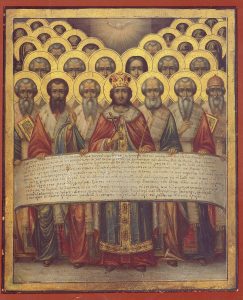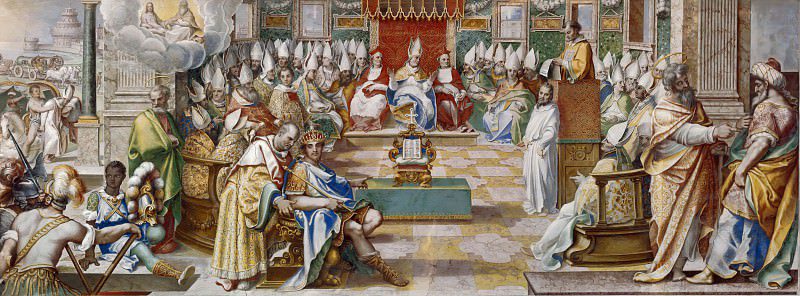1,700 years of the Nicene Creed
ORLANDO | The Nicene Creed, forged in 325 A.D., remains a cornerstone of Christian belief. Yet, its legacy is as complex as it is enduring.
As Pope Leo XIV marks the 1,700th anniversary with his upcoming trip to Turkey in November, voices in the Diocese of Orlando from Eastern and Western traditions reflect on unity, tradition, and the path forward.
It is important to understand why the Council of Nicea gathered. It did so to clarify the Church’s beliefs on the divinity of Christ and His nature, which had been confused under several heresies, the Arian heresy in particular, which questioned the divinity of Jesus. It established the Nicene Creed, affirming the equality of God the Father, God the Son, and the divinity of Jesus.
Although the council also attempted to settle a date on which to celebrate Easter, as the East followed the Hebrew calendar and the West followed the Julian calendar, it failed in that regard. With this year’s celebration of the Lord’s Resurrection falling on the same date, something that occurs every several years, Pope Leo made it a priority to work on the unification of Eastern and Western churches.
This milestone invites reflection on the Creed’s role in bridging divides between rites and deepening our connection to Christ, Church history, and one another.
Father Matthew Hawkins, pastor of Annunciation Parish in Altamonte Springs, recently led Bishop Robert Barron’s study, The Creed, at his parish. His goal was to “bring parishioners into a relationship with Jesus Christ; to come to know the God who made us, who is professed in the Creed,” he said and to commemorate the relationship with the history of the Church. “These are our doctrines that were developed over the centuries following the Apostles, and to recognize that it wasn’t all written down in stone from the very beginning, but there was a development in the Church that continues today. The Church in which we are still members.”
Growing up in the Antiochian Orthodox church, Father Hawkins said he hopes he spoke about the East “in very positive terms” so his parishioners could gain “an appreciation of a different expression of the faith.”
“St. John Paul II often talks about ‘the two lungs.’ They’re not meant to be one and the same, blanketing over the differences, but that each of the differences complement each other and build up a much stronger, much more beautiful and expressive church,” Father Hawkins said, adding the late pope emphasized the need for the Body of Christ “to breathe with both lungs, the East and the West.”
“The West has gifts that need to be brought to full fruition, and the East does as well,” Father Hawkins said. “As in any marriage, in the complementarity of a man and a woman, each of them brings their gift so the whole is greater than the sum of the parts.”
Father John Hamatie is pastor of St. George Antiochian Orthodox Church in Orlando. He agrees East and West have much to gain from one another and believes agreeing on a common date for Pasch or Easter “would really get attention.”
“The Roman Church is in great need of the spirituality of the Orthodox Church,” he said noting its mysticism, which is something he feels the Western Church has lost. “Our church is coming along, but it still needs more organizing in the way the Roman Catholics are. I respect it,” he said. “I think overall people are just finally realizing the emptiness of secular society and belief and they’re looking for something deeper.” He agrees with Pope Leo that “what we have in common is stronger, quantitatively and qualitatively, than what divides us.” But he said first we need to feel the pain of separation, so we may desire reconciliation.
Bishop John Noonan agreed and noted the difficulty created when there are divergent mindsets. “The Eastern Rite is very mystic. The Roman Rite is very concrete,” he said. “There must be a recognition of one another and a respect for one another- which I think Vatican II brought to a certain extent. But now we must move on from that. And it’s very hard to give up tradition,” he said.
He acknowledged the ability to dialogue and respect one another is a great thing. Pointing to a long history of disagreements since biblical times he said, “The Scribes and Pharisees were both Jews but didn’t agree. So, I think it’s very deep, not an easy thing to do. Theologically I think we can come together, but spiritually, our reality…I don’t know.”
Encouraged by Pope Leo’s efforts is Father Roman Kuzminskyi, pastor of St. Mary Protectress Ukrainian Church in Apopka. “As a priest of the Eastern Catholic tradition, I see unity as something deeply desired by Christ Himself, when He prayed ‘that they may all be one.’ Our Church is a witness that communion with Rome is possible without losing our Eastern spirituality and liturgy. Unity doesn’t mean uniformity — it means harmony in diversity, and I believe that’s where the Holy Spirit is leading us,” he said.

Noting, “True unity has to be a gift of the Holy Spirit,” Father Kuzminskyi, like Father Hamatie and Bishop Noonan, said he hopes “we can come together in Christ while still respecting our unique traditions.” He said, “The goal isn’t to erase differences, but to become one family where East and West enrich one another.”
Father Kuzminskyi believes unity is possible because theologically the churches are so close. He said what is needed is a softening of the human heart. “Old wounds, mistrust, and fear of losing identity keep us apart. Real unity will need humility, conversion, and the courage to see each other not as rivals from the past, but as brothers and sisters in Christ,” he said.
Noting Pope Leo’s desire for full communion with the East, Father Blake Britton of the Pontifical John Paul II Institute and a priest of the diocese, explains this is the very purpose of evangelization, to which we are all called. He said evangelization begins with “returning to the fundamental events of Revelation, as found in the Creed, as found in the profession of faith.” Explaining the Creed is “not a statement of facts, but a verb. It’s an action and part of that action is evangelization,” Father Blake said it is that evangelization that “manifests (the Church’s) holiness.”
“He explained the word “creed” or symbolon in Greek means “symbol of faith.” Because of that he said, “The Creed is a living event. It’s something that’s happening. It means to bring together, to bind together. And what binds us together is the truth of the Gospel. So, it’s something which the Holy Spirit’s actively doing to the Church.”
The Creed is not about stating the facts, he noted. “It’s rather that, when you’re professing the Creed, you’re actively naming the things that make you part of this communion. And in so doing, you’re actually manifesting the communion itself. You’re making it present in the world.”
He added, “To accept Christ means to belong to a people, to a community. That’s what the Creed does. It binds us in a two-fold way, on the one hand, with the Messiah who saves us in His blood and on the other hand, the sisters and brothers that blood has merited for us.” It is something that transcends linguistic and cultural boundaries, and time and space.
Affirming this was Pope Leo’s address to participants of the Ecumenical Symposium dedicated to the 1,700th anniversary on June 7, 2025. He said, “The Council of Nicea is not merely an event of the past but a compass that must continue to guide us towards the full visible unity of Christians.” He is convinced that “drawing from this common source, we will be able to see in a different light, points that still separate us,” and “by celebrating together this Nicene faith and by proclaiming it together, we will also advance toward the restoration of full communion among us.”
By Glenda Meekins of the Florida Catholic Staff, October 30, 2025

